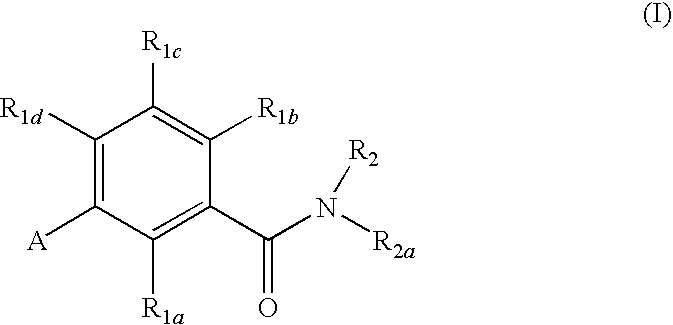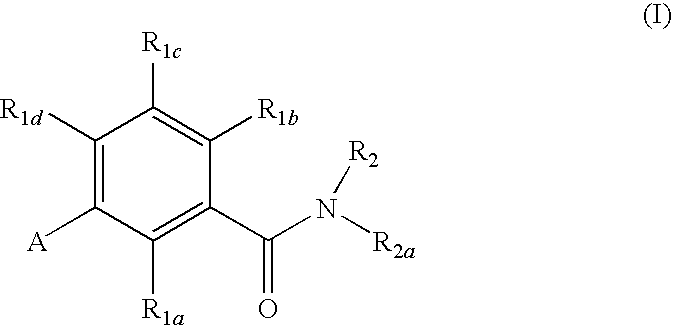Gonadotropin-releasing hormone receptor antagonists and methods relating thereto
a technology of gonadotropin and receptor antagonists, which is applied in the field of gonadotropin-releasing hormone receptor antagonists, can solve the problems of low bioavailability and adverse side effects of peptidic antagonists with low histamine release properties, and the clinical use of such antagonists
- Summary
- Abstract
- Description
- Claims
- Application Information
AI Technical Summary
Benefits of technology
Problems solved by technology
Method used
Image
Examples
example 1
5-Bromo-2-trifluoromethyl-isonicotinonitrile
[0251]
Step 1A: 5-Bromo-2-trifluoromethyl-isonicotinic acid
[0252]To a 100 mL round bottom flask equipped with a rubber septa and nitrogen inlet was charged 5 g (22.1 mmol) of 5-bromo-2-trifluoromethylpyridine. To the solid was charged 30 mL of anhydrous THF under a nitrogen atmosphere. After the solution became homogeneous, it was chilled with a −78° C. dry ice / acetone bath. To a separate 100 mL round bottom flask equipped with a rubber septa and nitrogen inlet was charged 3.4 mL (24.2 mL, 1.1 eq) of anhydrous diisopropyl amine. To the solution was charged 16.9 mL of anhydrous THF, placed under a nitrogen atmosphere and chilled with an ice bath. To the solution was carefully added 9.7 mL (24.3 mmol, 1.1 eq) of 2.5 M n-butyl lithium in hexanes. The light yellow LDA solution was chilled with a −78° C. dry ice / acetone bath. A 100 mL pear shaped flask equipped with a rubber septa, nitrogen inlet, stir bar, thermocouple and double headed cannula...
example 2
4-Chloro-3-(6-chloro-pyridin-3-yl)-N-(2-methoxy-phenyl)-N-methyl-benzamide
[0272]
Step 2A: 3-Bromo-4-chloro-benzoyl chloride
[0273]To 3-bromo-4-chloro-benzoic acid (9.4 g, 40 mmol) in dry DCM (100 mL), was added DMF (0.5 mL) followed by addition of oxalyl chloride (22.5 mL, 55 mmol, 2M in DCM) slowly. The mixture was stirred for 1 hr, then concentrated to yield 3-bromo-4-chloro-benzoyl chloride as an off-white solid.
Step 2B: 3-Bromo-4-chloro-N-(2-methoxy-phenyl)-benzamide
[0274]3-Bromo-4-chloro-benzoyl chloride in DCM (200 mL) was cooled in an ice bath and triethylamine (11.1 mol, 80 mmol) was added slowly, followed by the drop-wise addition of o-anisidine (4.5 mL, 40 mmol) in DCM (50 mL). At this time the ice bath was removed and the mixture was stirred for 12 hrs, followed by partition between DCM and water. The organic layer was washed with 1 N HCl, saturated NaHCO3, brine and dried over MgSO4. Concentration of the filtrate yielded 3-bromo-4-chloro-N-(2-methoxy-phenyl)-benzamide as a...
example 3
(2-{[4-chloro-3-(6-chloro-4-methyl-pyridin-3-yl)-benzoyl]-methyl-amino}-phenoxy)-acetic acid methyl ester
[0282]
Step 3A: 3-Bromo-4-chloro-N-(2-methoxy-phenyl)-N-methyl-benzamide (alternate synthesis)
[0283]To 3-bromo-4-chloro-benzoyl chloride (Step 2A, 14.4 mmol) in DCM (70 mL) cooled with an ice bath, was added methoxy-N-methylaniline (2 g, 14.6 mmol) in DCM (10 mL), followed by addition of diisopropylethylamine (3.4 mL, 18.95 mmol) slowly. Upon completion of the addition, the ice bath was removed and the mixture was stirred at room temperature for 48 hrs. The mixture was washed with 1 N HCl, saturated NaHCO3, and brine, dried over Na2SO4, filtered and concentrated in vacuo to yield 3-bromo-4-chloro-N-(2-methoxy-phenyl)-N-methyl-benzamide as a solid (5.1 g, 96%). MS [M+H]+: 355.7; tR=2.89 min. (method 1)
[0284]Similarly, 9.2 g (88%) 3-bromo-4-chloro-N-(2-methoxy-6-methyl-phenyl)-benzamide was prepared from 2-methoxy-6-methyl-phenylamine (4.2 g, 30.3 mmol). MS [M+H]+: 355.9; tR=2.80 mi...
PUM
 Login to View More
Login to View More Abstract
Description
Claims
Application Information
 Login to View More
Login to View More - R&D
- Intellectual Property
- Life Sciences
- Materials
- Tech Scout
- Unparalleled Data Quality
- Higher Quality Content
- 60% Fewer Hallucinations
Browse by: Latest US Patents, China's latest patents, Technical Efficacy Thesaurus, Application Domain, Technology Topic, Popular Technical Reports.
© 2025 PatSnap. All rights reserved.Legal|Privacy policy|Modern Slavery Act Transparency Statement|Sitemap|About US| Contact US: help@patsnap.com



